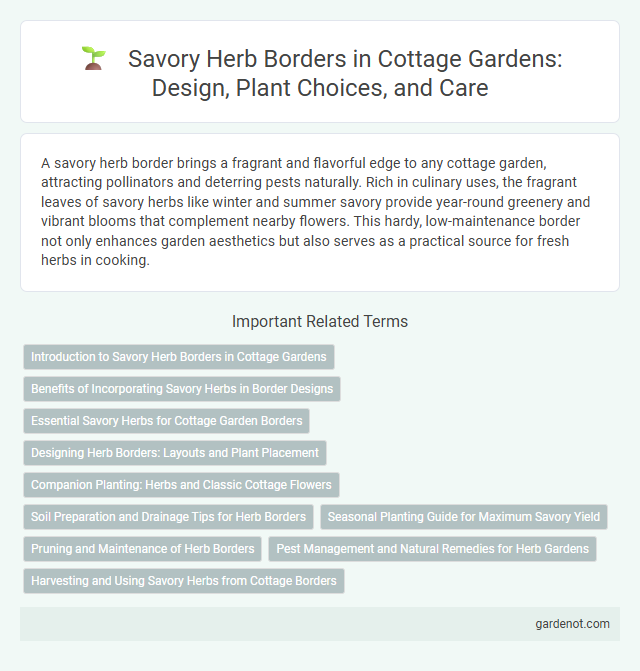A savory herb border brings a fragrant and flavorful edge to any cottage garden, attracting pollinators and deterring pests naturally. Rich in culinary uses, the fragrant leaves of savory herbs like winter and summer savory provide year-round greenery and vibrant blooms that complement nearby flowers. This hardy, low-maintenance border not only enhances garden aesthetics but also serves as a practical source for fresh herbs in cooking.
Introduction to Savory Herb Borders in Cottage Gardens
Savory herb borders are a classic feature in cottage gardens, prized for their aromatic leaves and attractive flowers. These borders typically include summer savory (Satureja hortensis) and winter savory (Satureja montana), both valued for culinary uses and pest-repellent properties. Integrating savory herbs enhances biodiversity while adding texture and fragrance to garden edges.
Benefits of Incorporating Savory Herbs in Border Designs
Incorporating savory herbs such as summer savory and winter savory into cottage garden borders enhances pest resistance by naturally repelling harmful insects. These herbs improve soil health through their aromatic oils, which can deter fungal diseases and attract beneficial pollinators like bees and butterflies. Their compact growth and fragrant foliage provide both visual interest and culinary value, making savory herbs a multifunctional choice for sustainable garden design.
Essential Savory Herbs for Cottage Garden Borders
Essential savory herbs for cottage garden borders include summer savory (Satureja hortensis) and winter savory (Satureja montana), prized for their aromatic leaves and attractive white to lilac flowers. These perennial and annual herbs thrive in well-drained soil with full sun, providing natural pest control while enhancing culinary dishes with a peppery flavor. Their compact growth habit and vibrant blooms make them ideal for defining pathways and adding sensory appeal to traditional cottage garden designs.
Designing Herb Borders: Layouts and Plant Placement
Designing a savory herb border in a cottage garden involves strategically arranging plants like summer savory, winter savory, thyme, and rosemary to optimize growth and aesthetics. Place taller herbs such as rosemary at the back or center, with low-growing varieties like thyme and savory along the edges to create layered texture and easy access. Incorporating companion plants with complementary blooms enhances pollination and maintains soil health, promoting a thriving, fragrant herb border.
Companion Planting: Herbs and Classic Cottage Flowers
Savory herb borders thrive when paired with classic cottage garden flowers such as roses, lavender, and foxgloves, enhancing both pest control and pollination. Companion planting with savory herbs like summer and winter savory improves soil health and deters pests by emitting strong aromatic oils that repel harmful insects. Integrating these herbs into herbaceous borders creates a balanced ecosystem that supports beneficial insects, promotes plant growth, and enriches the garden's visual appeal.
Soil Preparation and Drainage Tips for Herb Borders
For a savory herb border in a cottage garden, ensure soil is well-draining with a pH between 6.0 and 7.0 to optimize nutrient uptake and root health. Incorporate organic matter such as compost or aged manure to improve soil structure and moisture retention while preventing waterlogging. Raised beds or slight soil mounding can enhance drainage, reducing the risk of root rot common in savory herbs like summer and winter savory.
Seasonal Planting Guide for Maximum Savory Yield
Plant savory herb in well-drained soil during early spring to maximize growth and flavor throughout the season. Rotate between summer and winter savory varieties to ensure year-round harvest and maintain soil health. Regularly trim and harvest leaves to encourage bushier plants and higher savory yield in your cottage garden.
Pruning and Maintenance of Herb Borders
Savory herb borders in cottage gardens require regular pruning to promote bushier growth and prevent woody stems, ensuring a continuous supply of fresh leaves. Maintaining well-drained soil and removing any dead or diseased foliage helps prevent fungal diseases and supports healthy plant development. Seasonal trimming after flowering encourages regeneration and keeps the herb border tidy and productive throughout the growing season.
Pest Management and Natural Remedies for Herb Gardens
A savory herb border in cottage gardens naturally deters common pests such as aphids, whiteflies, and spider mites due to its strong aromatic oils. Utilizing companion planting strategies, savory works well alongside other herbs like basil and rosemary to reduce pest infestations without synthetic chemicals. Natural remedies like neem oil sprays and insecticidal soap enhance pest management while maintaining the herb garden's organic integrity and promoting healthy plant growth.
Harvesting and Using Savory Herbs from Cottage Borders
Harvest savory herbs like summer and winter savory from cottage garden borders just before flowering for optimal flavor and aroma. Harvest in the morning after dew dries to preserve essential oils, tying stems in small bunches to dry in a cool, airy place for long-term use. Use savory herbs fresh in salads, soups, and stews or dried to season meats, beans, and vegetable dishes, enhancing traditional rustic flavors.
Savory herb border Infographic

 gardenot.com
gardenot.com